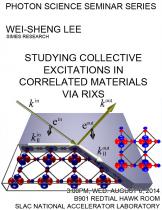Speaker: Wei-Sheng Lee, SIMES Research
Program Description
Characterizing elementary excitations associated with lattice, spin, charge and orbital degrees of freedom is a crucial approach to understand the complex phenomena exhibited in strongly correlated materials. Due to rapid improvements in instrumentation, resonant inelastic X-ray scattering (RIXS) has emerged as a powerful tool to study elementary excitations. In this talk, I will highlight some of our RIXS results on the studies of lattice, magnetic, and charge excitations in quasi-one-dimensional cuprate Y2+xCa2-xCu5O10 and electron-doped superconducting cuprate Nd2-xCexCuO4.
In the first part of my talk, I will discuss the role of the lattice in the quasi-one-dimensional edge-sharing cuprate Y2+xCa2-xCu5O10. Using oxygen K-edge RIXS, we resolve site-dependent harmonic phonon excitations of a 70 meV mode. Coupled with theory, this provides a direct measurement of electron-lattice coupling strength. In addition, the multi-phonon excitations soften when antiferromagnetic phase emerges, indicating that the magnetic and lattice degrees of freedom are intimately related.
In the second part of my talk, I will discuss collective excitations in the electron-doped superconducting cuprate Nd2-xCexCuO4 observed using copper L-edge RIXS. Surprisingly, despite the fact that the spin stiffness is zero and the AFM correlations are short-ranged, magnetic excitations harden significantly across the AFM-HTSC phase boundary, in stark contrast with hole-doped cuprates. Furthermore, we found unexpected and highly dispersive modes emanating from the zone-center in superconducting NCCO that are undetected in the hole-doped compounds. This may signal a quantum phase distinct from superconductivity. Our results indicate an asymmetry of the collective excitations in electron- and hole-doped cuprates, providing a new perspective on the doping evolution of the cuprates' ground state.
These two examples showcase the great potential of RIXS for revealing microscopic mechanisms in complex materials, which has spurred international races for building next-generation soft X-ray RIXS instruments at synchrotrons and X-ray free-electron lasers worldwide.





